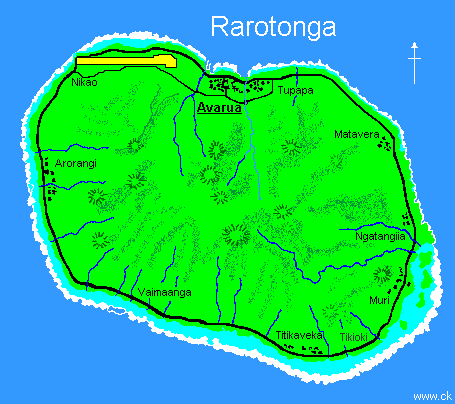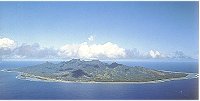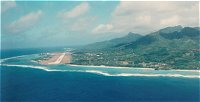 |
Rarotonga - The 'down south' island
RAROTONGA is the youngest island in the Cook Islands southern group and is physically unlike its other volcanic neighbors where erosion and periodic submersions have reduced mountains to gentle hills. Rarotonga's central massif is the eroded remains of a once mighty volcanic pyramid whose crags now form sawtooth peaks and razorback ridges covered with tropical jungle. These are separated by streams running down steep valleys.
The island stands 14,750 feet (4500m) above the ocean floor. It is 20 miles (32k) in circumference. At a depth of 13,000 feet (4000m) the volcano is some 31 miles (50k) in diameter. The highest peak is 2140 feet (658m) above sea level and the island is surrounded by a lagoon which extends several hundred yards to the reef which then slopes steeply to deep water.
Around the central mountainous area of this beautiful island is a narrow band of agricultural terraces and flats which, in turn, is encircled by a ring of swamps used largely for growing taro.
The climate is equable. Rarotonga is the second furthest south of the Cooks group and is almost exactly opposite Honolulu in relative latitude -- just inside the Tropic of Capricorn. It enjoys temperatures of between 64ºF (18ºC) and 82ºF (28ºC) in the southern winter which is May to October, and between 70ºF (21ºC) and 84ºF (29ºC) in the summer which spans November to April. The wet season is normally January to early May. Severe weather is seldom experienced. However, the El Nino weather pattern in early 2005 and an increase in sea temperatures near the Equator resulted in five cyclones in three weeks in February 2005.
| Max °C | Min °C | Sunshine hours | Rain (inches) | |
| Jan | 28.8 | 22.9 | 179 | 10.0 |
| Feb | 29.1 | 23.1 | 171 | 8.8 |
| Mar | 28.9 | 22.6 | 181 | 10..8 |
| Apr | 28.2 | 22.0 | 174 | 7.0 |
| May | 26.6 | 20.4 | 162 | 6.8 |
| Jun | 25.6 | 19.3 | 169 | 4.2 |
| Jul | 25.2 | 18.6 | 177 | 3.7 |
| Aug | 24.9 | 18.4 | 182 | 4.9 |
| Sep | 25.3 | 19.1 | 177 | 3.9 |
| Oct | 26.0 | 20.0 | 185 | 5.1 |
| Nov | 27.1 | 21.0 | 178 | 5.6 |
| Dec | 27.8 | 21.9 | 181 | 9.1 |
Rarotonga is the capital island of the Cook Islands and has the largest population. The encircling lagoon is a major tourist draw for Rarotonga and there are resorts and hotels all the way around the island. The most popular areas are the south-eastern corner at Muri where the the lagoon is deep enough for good snorkelling as well as the south and west coasts.
The island's present-day name stems from 'raro' meaning 'down' and 'tonga' meaning 'south'. The most popular version of its origin is that the famous Tahitian navigator, Iro, visited it once and some years later while on Mauke he met Tangiia who asked where he was going. Iro replied: 'I am going down to the south.' The Samoan voyager, Karika, is also reputed to have called it Rarotonga when he first saw it from the north-east because it was to leeward -- 'raro' -- and towards the south -- 'tonga'.
In 1997 Japanese archaeologists unearthed a previously unknown 'marae' -- sacred site -- on Motu Tapu, an islet in the lagoon at Ngatangiia. This is estimated to be 1500 years old which would put settlement much earlier than the legend of the arrival of Kainuku Ariki. Based on the evidence of fires, archaeologists have estimated that there was human life on Rarotonga about 5000 years ago. More on Rarotonga.
 |
Rarotonga is the entry point for the Cook Islands by air. From Rarotonga international airport Air Rarotonga flies to most of the other 15 islands in the group. See Travel
A list of places to stay is at Accommodation.
More detail on Rarotonga.
Also in Serbian
Also in Ukrainian
Also in Mandarin

